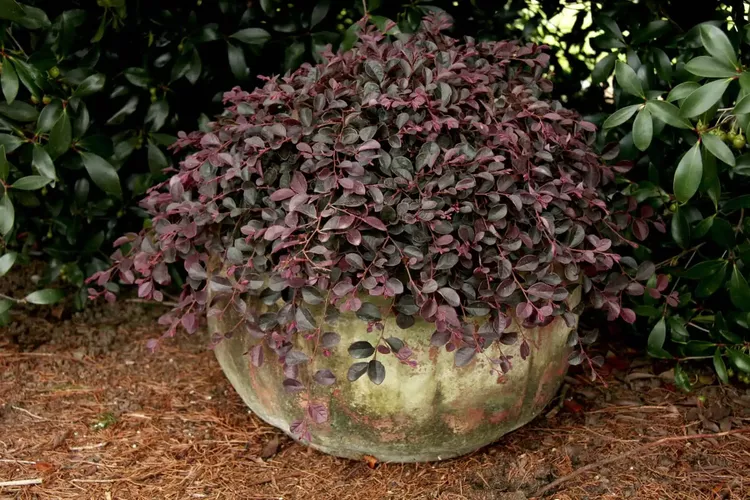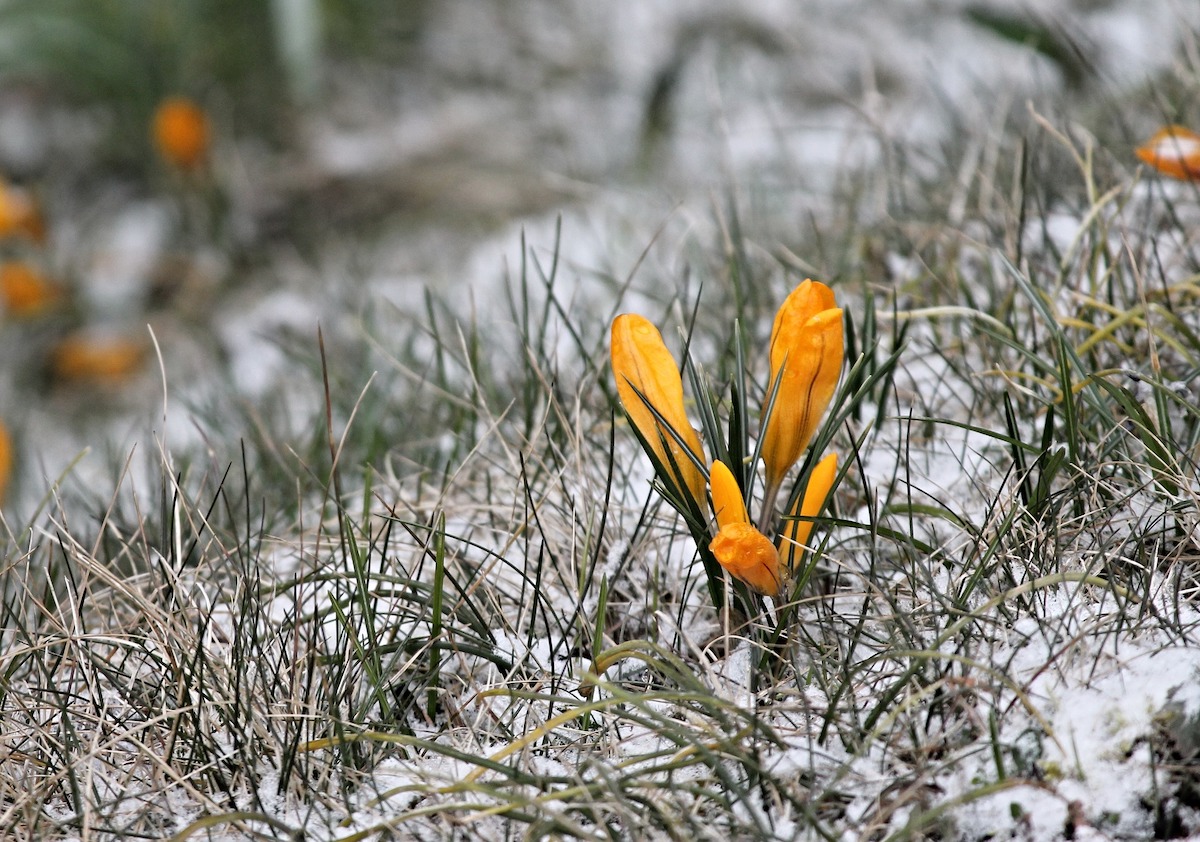

Old fashioned Loropetalums grow to gargantuan sizes, swallowing everything in their path, but not Purple Pixie® Dwarf Weeping Loropetalum. This compact variety hugs the ground, spreading its flowing limbs in graceful waves. With vibrant purple foliage, few plants look as spectacular spilling from containers or cascading over stone walls. The evergreen foliage does not fade in the summer or winter, providing rich color all year long. And spring brings a flush of magenta pink, tassel-like blooms, giving the plant one of its common names, fringe flower.
Purple Pixie® Dwarf Weeping Loropetalum dazzles in containers and brings movement and brilliant jewel tones to the garden floor. Plant singly for a punch of color in mixed plantings and entrance gardens, or plant in masses to carpet the ground in sun or shade. Purple Pixie® looks lovely flowing down slopes and over terraces, where it works to stabilize soil. Best of all, these pint sized Loropetalum don’t require a lot of pampering.
Purple Pixie® Dwarf Weeping Loropetalum Care
Loropetalums are easy to care for and rather low maintenance plants once established. Purple Pixie® Dwarf Weeping Loropetalum is hardy in USDA zones 7-10. Be sure to locate plants where they will thrive, starting with the proper soil conditions. Purple Pixie® plants require acidic soil with good drainage. If you live in the colder regions of its range, consider planting in a location sheltered from cold winter winds.
Light
This adorable Loropetalum thrives in filtered sun or morning sun with afternoon shade, but plants also tolerate full sun. Plants need at least four hours of direct sun each day for optimal bloom.
Soil
The proper soil conditions are critical for Loropetalum health. Plant Purple Pixie® in loose, loamy soil with good drainage to prevent root rot. Loropetalums thrive in acidic soils, but tolerate soils with pH between 4.0 and 7.0.
Water
Provide newly planted Loropetalums with regular irrigation for the first two years to establish a robust root system. Once established, Purple Pixie® is drought tolerant, however plants perform best with consistent moisture. Avoid overwatering, as Loropetalum roots can be prone to rotting in wet soil. Strive for moist but not soggy soil through occasional deep irrigation when rainfall is insufficient. Mulch plants with pine straw, shredded bark, or wood chips to retain soil moisture.
Temperature and Humidity
Loropetalums are sensitive to very cold weather. When temperatures are predicted to fall below 0°F, give plants a protective layer by covering them with blankets, burlap, or cloth tarps. Plants thrive in the heat and humidity of Southern gardens. Arid conditions can prove challenging. In dry climates, mist plants to maintain humidity.
Fertilizer
Purple Pixie® Loropetalum benefits from fertilizer applications during the growing season in spring and early-summer. If soil pH is adequate, use an all-purpose slow-release fertilizer or shrub fertilizer. If soil tends toward the neutral range, use an acid-forming azalea or camellia fertilizer. Follow the label instructions and water thoroughly after applying fertilizer.
How To Plant Purple Pixie® Loropetalum in the Ground
Purple Pixie® Dwarf Weeping Loropetalum is available from garden centers as potted plants that are easy to transplant into the garden in spring or fall. If you live in a colder climate, plant Purple Pixie® in spring to give plants time to establish before winter. Space plants according to their mature width, setting them slightly closer for mass planting and farther apart for use as an accent.
- Water potted Loropetalums well before transplanting to prevent the roots from drying out during the planting process.
- Dig a planting hole 2-3 times as wide as the root ball. This allows you to spread the root system.
- Gently remove the plant from its pot and loosen the roots.
- Set plants just deep enough that their root collars (where branches meet the root system) sit level with or slightly above the surrounding soil.
- Back fill the planting hole with soil, pressing the soil down gently with your hands.
- Water plants thoroughly and apply 1 to 2 inches of mulch, avoiding the area closest to stem.
Pruning Purple Pixie® Dwarf Weeping Loropetalum
Purple Pixie® requires very little pruning to maintain its ground-hugging stature. If you wish to shape plants or reduce spread, wait to prune until after spring flowering is completed, otherwise you risk cutting off the flower buds. Dead, damaged, or broken branches can be removed at any time, cutting them back to a healthy lateral branch or the main trunk.
When pruning to limit spread, strive to maintain Purple Pixie® Loropetalum’s free-flowing form by making cuts at different lengths. Trim stems back to a side branch, leaving some stems longer than others. This helps maintain the shrub’s natural appearance.
How To Get Purple Pixie® Loropetalum to Bloom
Loropetalums bloom best when they receive ample sunlight. Be sure the planting site receives at least four hours of direct sun each day. If sunlight is insufficient, consider transplanting shrubs to a sunnier location or trimming a few overhead branches to allow more light to penetrate. Pruning Purple Pixie® Dwarf Weeping Loropetalum at the wrong time of year can also reduce flowering. Do not prune in winter or early spring. If needed, wait until after the spring flowering season to prune plants.
Overwintering Purple Pixie® Dwarf Weeping Loropetalum
Mulch Purple Pixie® with pine straw, leaves, or bark in late fall or early winter to moderate soil
temperatures and reduce disruptive freeze-thaw cycles of the soil. Like other broadleaf evergreens, Loropetalums benefit from protection against strong winter winds to avoid desiccation. This is particularly important in the colder regions of its range and is best addressed by selecting a protected site at planting time. Likewise, broadleaf evergreens need moisture throughout the winter months to prevent desiccating. Make sure plants are well watered going into fall and winter. Continue watering about once a month to keep the soil moist, but not wet. Stop irrigating if the ground freezes or snow falls.
Although Purple Pixie® is an evergreen plant, some leaf drop can occur in winter, particularly in colder climates. Plants can also be damaged by extreme cold. Cover plants with burlap, blankets, or shrub wraps if temperatures are predicted to fall below 0°F.
Plants growing in containers are less insulated against cold temperatures and need protection when temperatures fall below 20˚F. When possible, move potted plants to a more sheltered location to protect against winter winds and temperature fluctuations. Apply a thick layer of pine straw or leaf mulch on top of the potting soil and water containers regularly. Containers will dry out more quickly than ground soil, even in winter.
Insulate potted Purple Pixie® plants by wrapping several layers of plastic ‘bubble wrap’ around the container, extending to ground level. Another option is to mound mulch around the pot and wrap in a heavy blanket or burlap. Consider moving potted plants into an unheated garage when below-freezing conditions are expected.
Propagating Purple Pixie® Dwarf Weeping Loropetalum
Purple Pixie® Dwarf Weeping Loropetalum is patent-protected and cannot be propagated.
Potting and Repotting Purple Pixie® Loropetalum
With its compact size and evergreen foliage, Purple Pixie® Loropetalum makes an excellent container plant. The flowing foliage looks magical cascading from window boxes, urns, and other raised planters that allow the branches room to trail. Purple Pixie® stems tend to mound up slightly
before spilling, giving containers a dense, full appearance.
Select containers with good drainage and use frost-proof pots in areas where frost is expected in winter. When repotting Loropetalums, select a container that is one to two sizes larger than the current pot. Evaluate the root ball of newly purchased plants and size containers accordingly, giving plants a little room to grow into, but not too much extra space.
Plant Purple Pixie® Dwarf Weeping Loropetalum in a well-draining, acidic potting mix such as a commercial mix labelled for rhododendrons and azaleas or camellias. You can mix your own potting blend by combining equal parts coarse sand, finely shredded pine bark, and oak leaf mold. Container-grown Loropetalums perform best with morning sunlight and protection from hot afternoon sun, or under filtered light all day.
Remember that potted plants dry out faster than those planted in the ground. Water containers deeply when the upper two inches of soil feels dry to the touch. Fertilize potted Loropetalums with a water-soluble fertilizer for acid-loving plants according to label directions from spring through mid-summer.
Common Pests & Plant Diseases
Purple Pixie® Dwarf Weeping Loropetalum makes a wonderful pest resistant selection for the landscape. Plants are not bothered by any serious insect or disease problems. Occasional pest outbreaks can occur, particularly when plants are stressed due to drought or other factors.
Watch for mites and aphids, which can easily be washed from plants using a heavy stream of water. Persistent problems can be treated with an insecticidal soap or horticultural oil. Scales can also impact stressed plants and are best avoided by maintaining plant health through proper watering and fertilization. Heavy scale infestations can be managed through selective pruning to remove impacted branches or treatment with horticultural oil.
Like many landscape shrubs, Loropetalums can be impacted by powdery mildew and anthracnose. Adjusting cultural practices is the best way to manage these diseases. Reduce humidity in the leaf canopy, which encourages disease, by avoiding overhead watering and promoting good air circulation through proper plant spacing. Infected plants can also be pruned to remove severely diseased branches or treated with fungicide. It is important to note that fungicides do not cure plant
diseases but can help reduce the spread to healthy plants and stems.
Bacterial gall can also impact Loropetalums. This disease causes branch dieback and can ultimately kill shrubs and is recognizable by dark-colored galls on branches. Prune infected branches out by cutting several inches below the galls. Dispose of the cut branches in the trash and disinfect tools with a 10% bleach solution or rubbing alcohol. There is no cure for bacterial gall, however, pruning can limit spread. Likewise, treating diseased and healthy plants with fungicide can reduce the spread of this disease.
Common Problems
Most problems with Loropetalums can be avoided through proper plant placement and care. For example, root rot can be avoided by planting in soil with good drainage and avoiding excess irrigation. Cultural problems can be detected by watching for leaf discoloration.
Yellow leaves, a condition called chlorosis, may indicate the soil is too alkaline, while brown leaves may be a sign of cold damage, under-watering, or over-fertilization. A soil test is the best way to determine if soil pH or nutrient problems are the cause of plant stress. These can be easily remedied by amending soil pH with elemental sulfur or adjusting fertilization practices.
If soil tests determine that soil conditions are not the root of the problem, look for other signs and symptoms. Cold damage and soil moisture problems are easy to rule out based on weather and irrigation patterns. Plant diseases can also cause leaf discoloration. Powdery mildew and anthracnose may cause leaves to turn yellow, but is accompanied by other symptoms. In
the case of powdery mildew, white or gray powdery looking growth will be visible on the foliage. If leaves prematurely wither and drop, this may be a sign of anthracnose.
Despite these occasional challenges, Purple Pixie® Dwarf Weeping Loropetalum is overall very easy to maintain. Proper irrigation and fertilization go a long way toward maintaining healthy, beautiful plants. Purple Pixie® is deer resistant and drought tolerant once established. And for the most part, you can skip pruning all together. What more can you ask from this dazzling shrub?

